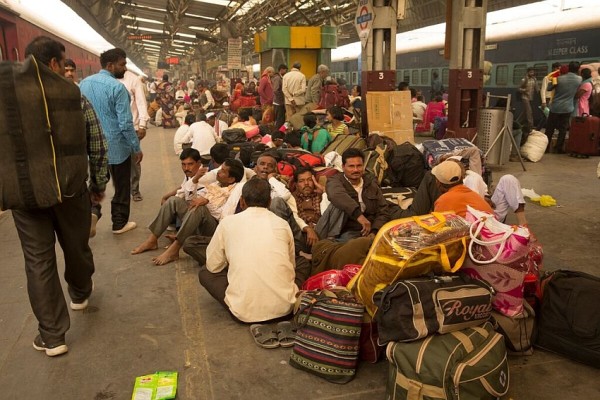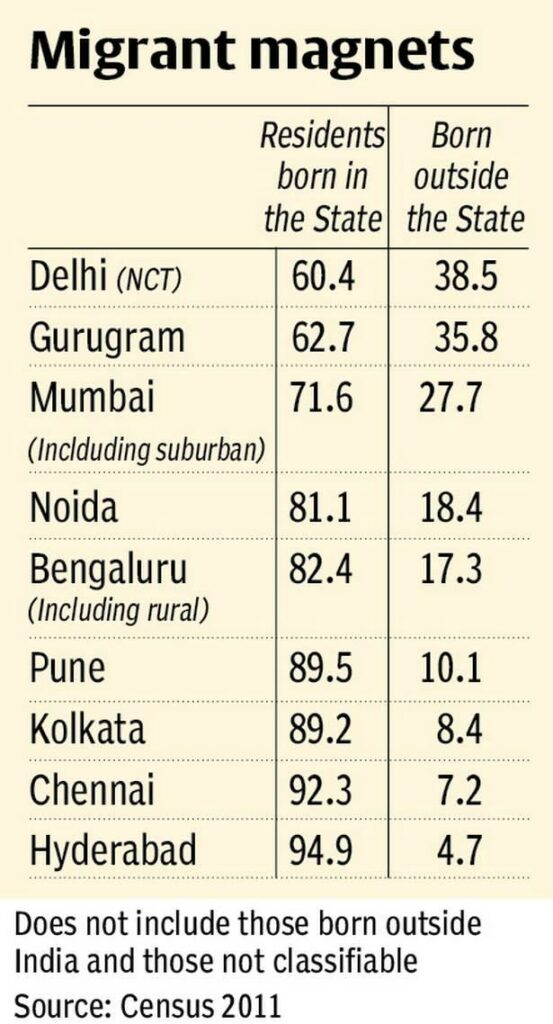By Shaunak Kishor Tapaskar, National Rail & Transportation Institute, Vadodara.
Migration is considered as a prime feature of today’s globalized world. People migrate from their places of origin to aspire for a safe and better future. In India, especially in its National Capital Region (NCR), we come across a similar phenomenon. NCR is the world’s largest urban agglomeration (UA) with a population of about 46 million. This region comprises of prominent cities like Delhi, Gurugram, Noida, and Ghaziabad. Among them, Delhi is the most populous with 18.6 million people and is also known as the National Capital Territory (NCT). Delhi’s booming services economy and its hegemony as the city with the highest per capita income in India makes it the migrant magnet. According to the 2011 census, nearly 40% of Delhi’s population comprised of outside individuals, which is the largest share among Indian cities, making it the ‘migrant capital’ of India. It also has the second largest population for inter-state migration, trailing only behind the state of Maharashtra. In Delhi, more than 75% of the total migrants are from the two states of Uttar Pradesh and Bihar. Among the Indian states, the share of migrants from Uttar Pradesh, Bihar, Jharkhand, and Uttarakhand towards Delhi and its surrounding NCR consistently increased between 1991 and 2011.
According to the National Capital Region Planning Board (NCRPB), urbanization in NCR increased from 50% in 1991 to 62% in 2011. It is projected to reach 73%, according to the Regional Plan 2021, which is a policy initiative to develop the region further and decongest the dense population of Delhi. The migration, as a result of rapid urbanization in the NCR, has caused congestion and ecological issues. The NCR also consists of ecologically sensitive places like the Yamuna River, Aravalli ridge, forests, and wildlife sanctuaries, which are facing risks of encroachment due to constant urbanization and construction activities. The ecological impact is defined as the effect of human activity on living organisms and the surrounding non-living environment, i.e., air, water, soil, amongst others. According to a study titled, “Impact of In-migration on Environmental Quality of Delhi”, by Md. Safikul Islam and Lubna Siddiqui, most migrants are settling down in the NCR due to factors like employment, education, marriage, business or administrative work. The high rate of migration in Delhi NCR leads to more people needing housing, stress on water resources, a surge in vehicles, increased use of wood, stress on public transportation and a colossal increase in the demand for energy in general.
According to the late former Chief Minister of Delhi, Sheila Dixit, “Towns like Noida and Gurgaon have not served their purpose in decongesting the capital (Delhi). The burden of increased migration cannot be borne by Delhi alone. For example, the figures show that between 32 to 36 percent of patients in government hospitals in Delhi are from outside the city. To ensure a better future, we need to plan better.” One of the measures taken to contain the influx of migrants was the development of 135 urban villages across Delhi. These settlements went through the gentrification process to become commercial and residential centers. Due to availability of cheap rents and shopping centers, migrants and businessmen entered these villages and now the tenants have outnumbered the original residents. However, this influx of migrants created acute problems of water scarcity and improper waste disposal since the development was carried out without taking into account the lack of basic amenities beforehand. Thus, due to lack of proper planning, these villages are filled with garbage flowing out of sewer lines and the neighborhood space has been shrinking. To solve the problem of migration in Delhi and its surrounding NCR, policies like densification are being looked into. Although it can be argued that the policy of densification has created more housing and jobs, in the absence of accompanying public infrastructure and environmental safeguards, this densification has indirectly led to severe ecological consequences for Delhi.
 (Yamuna River with a layer of toxic foam over it)
(Yamuna River with a layer of toxic foam over it)
The Yamuna river, which is the primary source of Delhi’s drinking water, is, according to water pollution experts, dying owing to factors like ecological pollution, contamination and riverbed encroachment. The construction industry in the NCR is also responsible for severe ecological consequences resulting in air, water and soil pollution. The associated problems are so dangerous that the Delhi government, along with some neighboring states, had to ban all construction activities for a few days in the opening week and in the middle of November 2019 in the NCR. Studies have suggested that India’s brick industry contributes nearly 10% of India’s emissions of black carbon, a significant contributor to climate change. Since 1980-81, the area in Delhi under residential built-up has increased while the fallow land net sown area has decreased proportionally. However, with efforts by Delhi’s government, the green forest and tree covers have been increasing steadily.
Bad quality of air is also one of the rising consequences of rapid urbanization and migration. In the first week of November 2019, most regions in Delhi-NCR had severe levels of air quality. Annually, dust coming through Delhi’s 9 Million cars is a significant contributor to air pollution. The harmful pollutants from vehicles emitted bind to the dust and settle in the air.
The deluge of job-seeking migrants has placed a colossal strain on Delhi-NCR’s ecology. Basic facilities like clean water and sanitation have not been provided to most migrants due to government negligence and stress on ecological resources. The rapid urbanization of this region has come at the cost of frequent congestion and a decline in air quality. Some proper policy interventions like development of mass transit systems throughout the NCR, check on illegal construction, use of advanced waste management systems, reducing the influx of migrants by providing jobs at their native places, amongst others, need to be taken up on an urgent basis; such solutions could play a key role in tackling the huge ecological consequences of migration in NCR and ensure peaceful coexistence of future generations.





